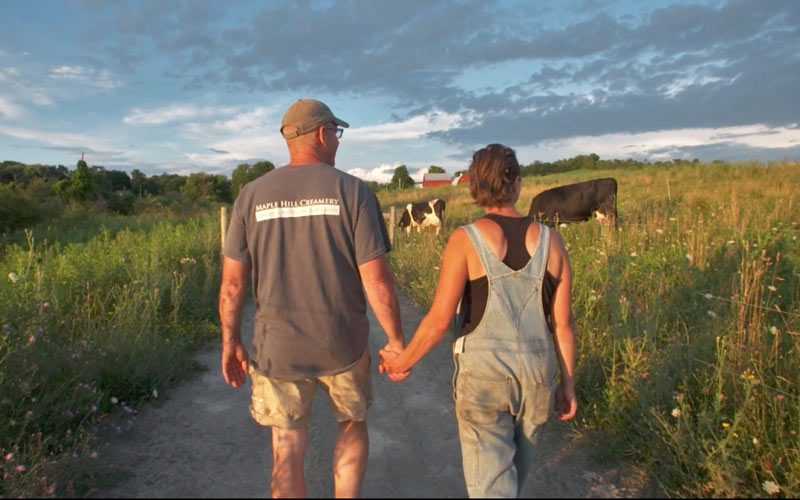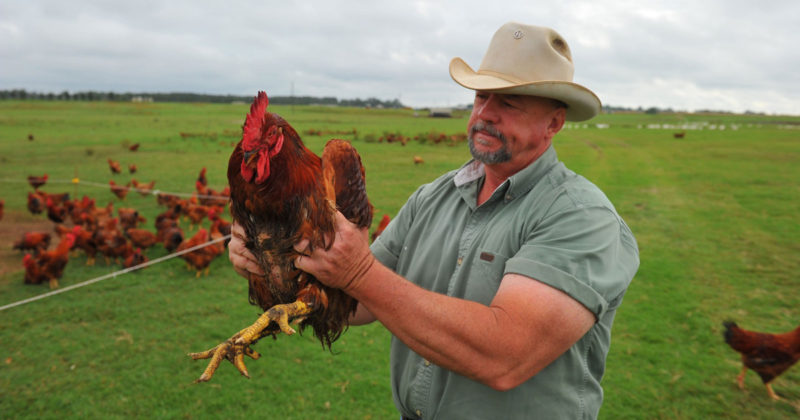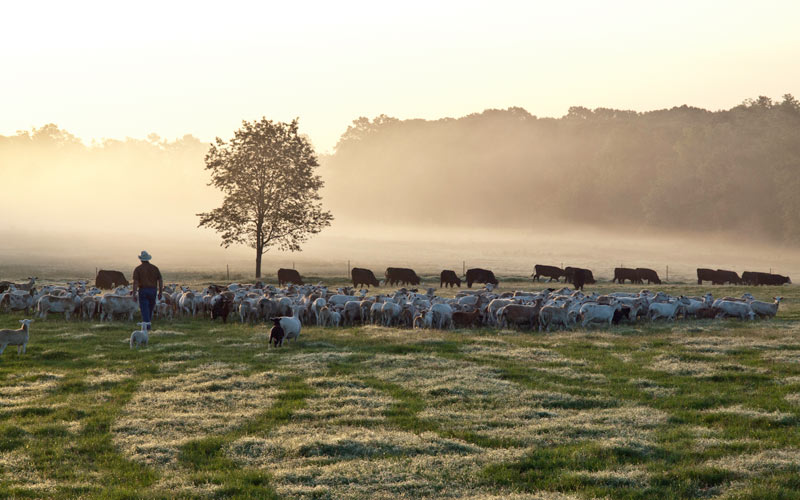Slow Money: Scaling Global Solutions Is a Local Proposition
by Daniela Ibarra-Howell | May 2, 2018
For many years, agriculture—or the production of food and fiber—has resulted in the massive degradation of billions of acres of land worldwide. Now, the same industry finally has been acknowledged as having the unique ability to sequester carbon through the improvement of soils, representing a viable and promising global solution to climate change.
Grasslands occupy 30% of the world’s land surface. Their deep soils have the capacity to store substantial amounts of carbon. Grasslands are degrading at an alarming rate, however, and until now they largely have been ignored in the climate agendas. Loss of grasslands leads not only to climate change, but to floods, droughts, famine, and worldwide poverty.
The Holistic Management of grasslands and livestock has been proven key to restoring land, boosting soil fertility, mitigating floods, enhancing drought resilience, increasing the nutritional value of food, and restoring wildlife habitat—and it simultaneously sequesters carbon. Additionally, the one billion people who live on and derive livelihoods from grasslands, as well as livestock, can increase their well-being in the process of saving the planet. All of us—including consumers—can accelerate this shift in agriculture toward a regenerative model via informed purchasing decisions. How can we accomplish this monumental task? Read on.
Local Not Only Matters, It Is the Only One Reality
Can a local leader run a profitable livestock business, heal the land, and change the world for the better? The answer is absolutely “Yes,” no doubt. I just returned from White Oak Pastures (WOP) in Bluffton, Georgia. My mentor, friend, and leader—holistic farmer Will Harris—owns and runs WOP. Will is well-known in the regenerative ag space.
What differentiates WOP is that not only is the land regenerating under Will’s management, but a whole town has been revived. Will’s farm also is solidly profitable. What is most important to his enduring success? According to Will it is resilience. He has succeeded at combining land and livestock management, has achieved business success, and has created social wealth in a model that has integrity and should be replicated. Will has moved from the extractive model of industrial agriculture that has defined the “success” and profitability of farmers for the past 50-plus years (with incredibly negative, unintended consequences via the liquidation of ecological and social capital), and now practices Holistic Management. He is rebuilding ecological and socio-cultural wealth while remaining profitable—a lot more profitable and more resilient than ever before. Committing to a regenerative model provides virtually endless opportunities for profitability.
Cattle, goats, and sheep move strategically around the farm under holistic planned grazing; chickens, geese, turkeys, and ducks follow grazers and peck at grubs and insects, thus managing pest cycles; hogs and rabbits do their part and add more complexity and resilience to the whole livestock mix. The farm produces pastured eggs and grows numerous types of heritage vegetables. At WOP, no species is confined, no hormones are used, and animals do not endure long rides in trucks—animals are always in pastures, and are slaughtered and processed in the farm’s USDA-inspected plant, which is powered by solar panels. Everything from the farm is used or goes back into the land—waste is nearly zero.
The whole family is happily involved in various aspects of running this complex business. Employees—more than 100 of them—come from diverse backgrounds and all see their jobs as both incredibly important and of high quality. Clearly, WOP represents a socially, ecologically, and financially regenerative model.
We believe that the local movement is about the decentralization, de-industrialization, and de-commoditization of the food (and fiber) industries. We believe that it is grown by a group of passionate people who are bound by family core values, rather than by faceless corporations that are bound by quarterly earnings reports.” —Will Harris, White Oak Pastures
White Oak Pastures also is a demonstration and training site for other local farmers; some of them work with and supply animals to WOP. Will Harris is the leader of the Georgia Savory Hub. The Savory Hub is dedicated to demonstrating the holistic framework and practices, training and supporting other farmers in the region in all aspects of Holistic Management, incubating and disseminating holistically sound solutions, and serving as a research site for relevant science focusing on livestock management and the health of soil and grasslands.
Now We Go Global
This incredible story is replicable, not as a formula for all farmers but as a model of what happens when we start paying attention to all aspects of successful agriculture—soil, plants, animals, people, and finances. The integrated return on investment is mind-blowing.
In each regional and local context; on each farm, ranch, or landscape; and within each human group, answers will differ and creativity will dictate and unveil different possibilities, but the fundamental principles of building resilience and fostering regeneration remain the guiding stars.
This is exactly what the Savory Hub network is designed to do. Just as WOP serves as a Savory Hub of holistically regenerative solutions in Georgia, a burgeoning global network of 30-plus Hubs on six continents is doing the same. From Turkey to the United Kingdom to Spain, from southern Africa to Patagonia, from Australia to Canada, the “WOPs” of the world are at work to make regenerative livestock agriculture a reality. The key to scaling the Savory strategy is to embrace, incentivize, and support the beauty and uniqueness of what is local; safeguard the integrity of processes; and promote contextualized replication through local leadership and long-term investment. Not one big top-down initiative, but rather countless smaller grassroots gems activating the models for agriculture we need in a regenerative, circular, edge economy as offered by Hunter Lovins, John Fullerton, and others.
A Strategy Is Born
Backtrack seven years, to when I took on the leadership of the Savory Institute. We set out to take Allan Savory’s lifework to a whole new level, to a visible and coordinated realization of Holistic Management across multiple social actors in all socio-political, ecological, and economic contexts worldwide. It had to become a tangible reality. Land is desertifying at an alarming rate. Grasslands until very recently were ignored in both agriculture and climate agendas.
Our pledge: That all our initiatives would have an underlying self-sustaining or—even better—regenerative business model supporting them. Year after year, ideas were vetted, business plans were put in place, tools and programs were developed, partnerships formed and were nurtured, and an increasingly strong network of close and allied partners began forming the entrepreneurial infrastructure through which knowledge, tools, and assets are distributed, and our common mission is realized.
The hero in our story continues to be the holistic farmer, rancher, pastoralist—working day in and day out, sunup to sundown, to produce our food and fiber in ways that heal the land, sequester carbon in our soils, steward the habitat of many species, and recharge our water tables.
Now these heroes would be united in a local tribe, coordinated and orchestrated by a local entrepreneur. A solutionary. An advocate. A businessperson. A marketer. A facilitator. A trainer. A philosophically aligned organization. This local figure would create, lead, and help replicate a self-sustaining initiative—just as Will and his family and team are doing at WOP—with deep understanding of the context in which it is operating. These are the Savory Hubs, our scaling infrastructure, our distribution and deployment mechanism.

Paul and Phyllis Van Amburgh are Holistic Management–accredited professional educators who co-manage Dharma Lea grass-fed dairy and beef farm (Sharon Springs, New York), which is one of the Savory Institute’s Hubs.
With all its growing pains; learning curves; and constant monitoring, adjusting, and re-planning—which is the core of Holistic Management—this burgeoning network of Savory Hubs is growing strong and is collaborating in novel and unexpected ways. The integrity of the local context is protected, respected, and (in many cases) restored. The soundness of the processes and practices promoted evolves and strengthens through peer-to-peer modeling and support, skillful implementation, ongoing learning, and relevant scientific research. Soil microbes are being fed, nutrients are cycling into better and richer food, human health and animal health are being positively impacted, plants are drawing carbon into the soil making it richer and more productive, water is being soaked up by soils and supporting life, community passion is reigniting, younger generations are engaging, and money and resources are reinvested, strengthening the circular economy. If we zoom out to examine the large network, the sum of these local initiatives clearly is addressing the global food, water, climate, and economic crises.
The Power of All of Us through the Marketplace
The network is now positioned to accelerate our joint impact, as world and business leaders look for actionable strategies to meet their corporate social responsibility, sustainability, and climate commitments, and as all of us consumers of food and fiber become increasingly astute, educated, curious, and demanding when it comes to understanding the impact, quality, and authenticity of the products we buy and the brands we support.
Grassroots and collaborative programs need to facilitate an interactive market and production network for food and fiber products that regenerate the land. One such program is being prototyped with a handful of Hubs, their producer networks, and select market partners. The intelligence inside the program is unquestionable: the measurement of key indicators of ecological health of the land, such as soil carbon and microbiology. This program, deployed by the Hub network, will facilitate the sourcing of regenerative raw materials to ecologically and socially conscientious brands with a deep commitment to incentivize regenerative models. It will enable consumers to buy food and goods derived from livestock that is properly managed through practices verified to enhance water availability, soil health, carbon sequestration, and wildlife habitats. Producers learn, improve their management practices and outcomes, and gain differentiation. Brands gain access to regenerative producer networks, volumes, and data-based transparency. Hubs engage as problem solvers and service providers for livestock producers, verifying outcomes and coordinating market opportunities in their own well-known, specific socio-cultural, political, economic, and ecological contexts.
The sky is the limit in how wide, far, and fast this movement can go in contributing to the global solutions required in our challenging times. A few innovators spread across the globe are willing to lead and minimize risk for livestock producers around the world, and to model what progressive brands, conscientious retailers, educated consumers, and slow money can do to foster a regenerative agriculture movement that is transparent, meaningful, profitable, and resilient, and builds from the ground up to achieve global impact.

